#Lolita Fashion History
Text
Mini Lolita Fashion History Lesson: MILK
Today, MILK is generally known as an 'otome' or 'girly' brand, and many of their modern items don't look like what modern lolita think of as lolita.
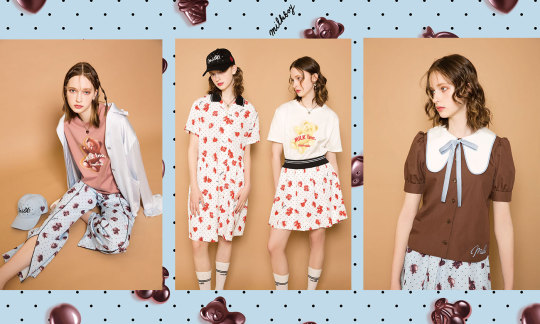
A recent MILK collection
However, in the late 80s and early 90s, MILK was considered to be one of the quintessential Lolita brands.


1990s lolita wearing MILK
In a 1994 zipper interview about the history of lolita fashion the brand representative for MILK states "I think what is now called lolita fashion is the fashion that milk has been making for a long time."
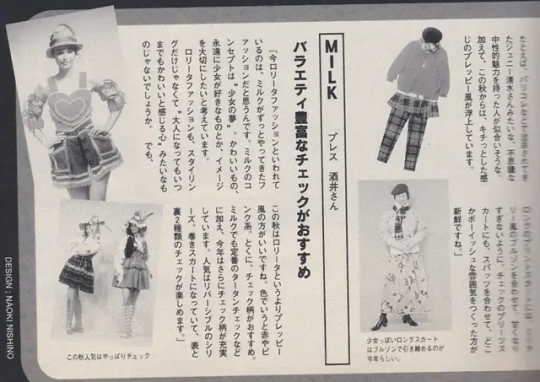
MILK was founded in 1970 by Hitomi Okawa (大川ひとみ). When Hitomi Okawa started as a designer there were not many DC brands yet and ready to wear fashion was really just starting to become more widespread in Japan. Okawa attended an art university in Kyoto because of a love of drawing that started in elementary school. She used to draw illustrations of girls and make things like paper dolls. At the age of 11, she drew many pictures of the same clothes and changed the patterns (polka dots, checks, flowers). She grew up the daughter of a doctor, in an affluent home where her mother would read magazines like Harper's Bazaar with 1950s and 1960s American fashion. She also looked at American fashion catalogs as a child, and cites this study of clothing in magazines and catalogs as her earliest sort of "studying" of fashion.

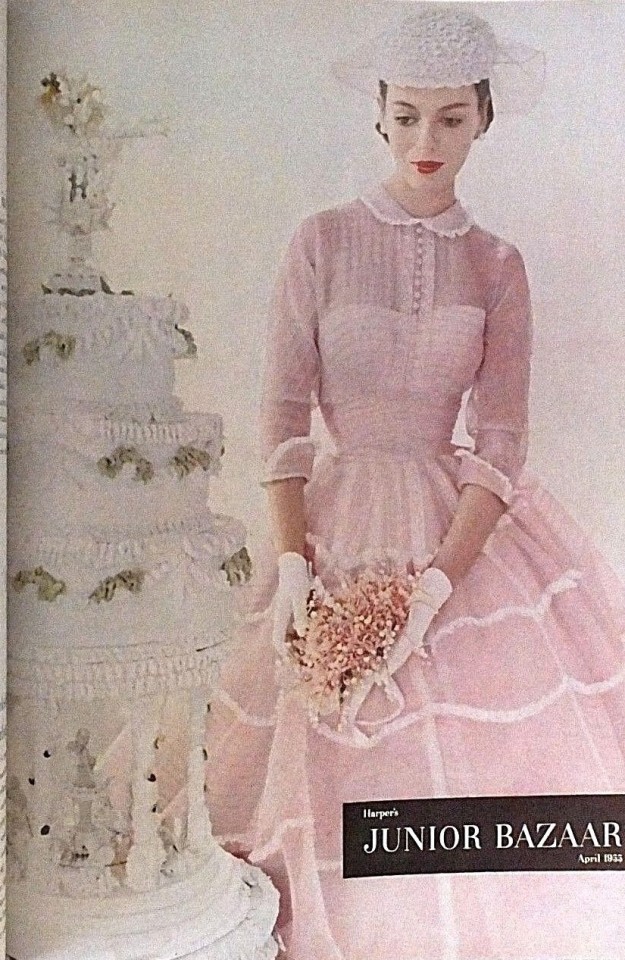
50s/60s Harper's Bazaar
In addition to drawing inspiration from the 50s & 60s Harper's Bazaar & American clothing catalogs, she also drew inspiration from military uniforms and how they have custom buttons and custom fabric and details like that, as well as current trends in London and Tokyo as the brand continued to develop. When she started however, she says that she was the only one making this sort of cute girly clothing in Japan and she felt like she had to make it because no one else was making what she wanted to wear.
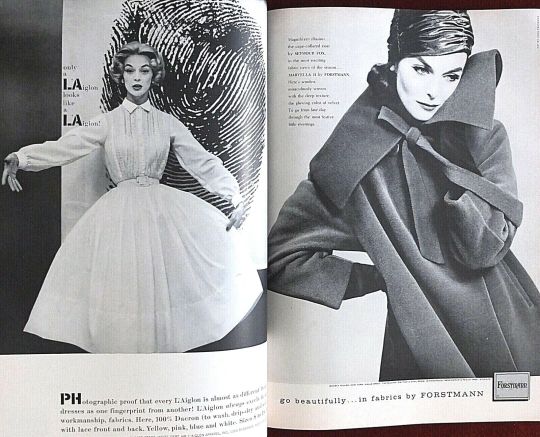

50s/60s Harper's Bazaar
After graduating from Seian College of Art and Design, Department of Design, she started MILK in Harajuku. She wanted to start in the coolest place possible, so she decided on Central Apartment.
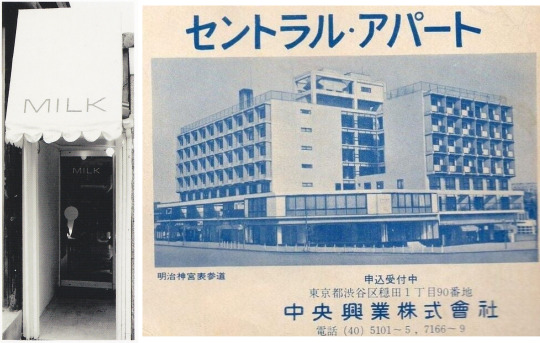
MILK Shop Front in the 70s, Central Apartment
She had come to Harajuku when she was either in High School or her first year of University and had stood in the middle of the pedestrian bridge right off Harajuku station, and she looked down at Omotesando and thought "Here is the coolest place, I want to be here!", and that's why she chose that location. The Bridge doesn't exist any more, it was torn down in 2011. She wasn't aware at the time that Central Apartment was a popular place for creators, she just thought that street was nice and that Central Apartment was modern and cool. In a 2021 interview she confessed that she sometimes still goes up to the pedestrian bridge on the Yoyogi Park side and looks at Omotesando, and when she does, she feels the same way she did when she was 20 years old.
Central Apartment (原宿セントラルアパート) was initially an apartment complex built in Harajuku in 1958 at the intersection of Meiji-dori. It was initially built for special international travelers like US military personnel. In the mid 1960s/early 1970s, the lower floors were converted into stores with offices in the upper apartment floors.
The Coffee shop Leon on the first floor was a popular spot with creative people. There were also shops like Mademoiselle Nonnon launched by designer Taro Aramaki which sold French style clothing and lots of horizontal stripes. Mademoiselle Nonnon is considered to be the source of the border (horizontal stripe) trend in Japan.
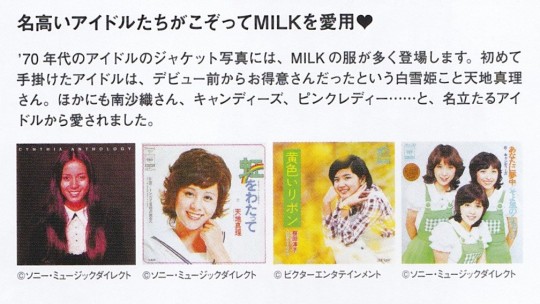
Initially, "MILK", was expensive and unrealistic for everyday wear, so it was mainly used as a stage costume for idols, however, people started wearing Milk as everyday clothing as time went on.
MILK also experimented with a Bridal line in the 70s as well.
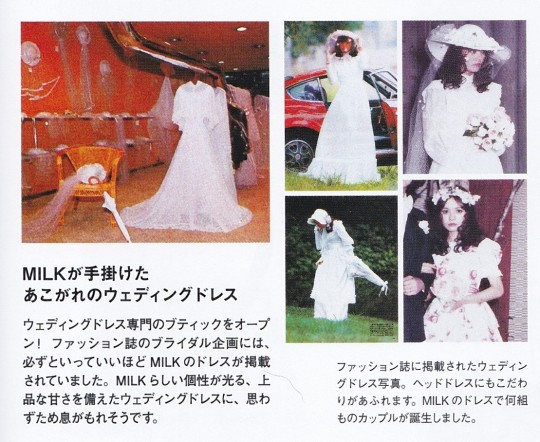
While their runway looks were generally a bit more loud than the way the pieces would have been worn in real life, you can see some prairie revival influence their early 70s items as well as some silhouettes in the '76 collection that are starting to look more lolita-esque.
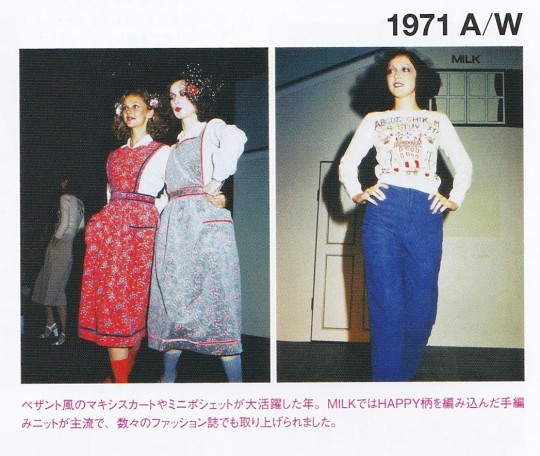
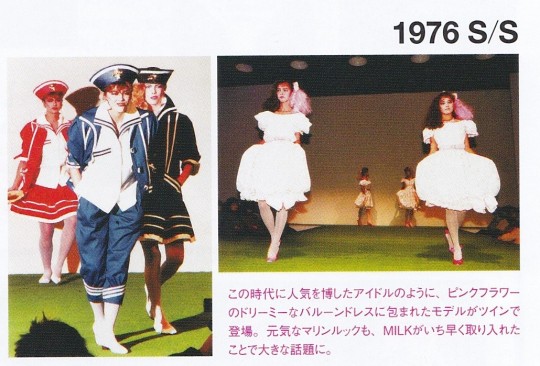
Here are a few runway examples from the 1980s, note the border print of a carousel in the 1988 collection and the knee length ruffled skirt in the 1982 one.
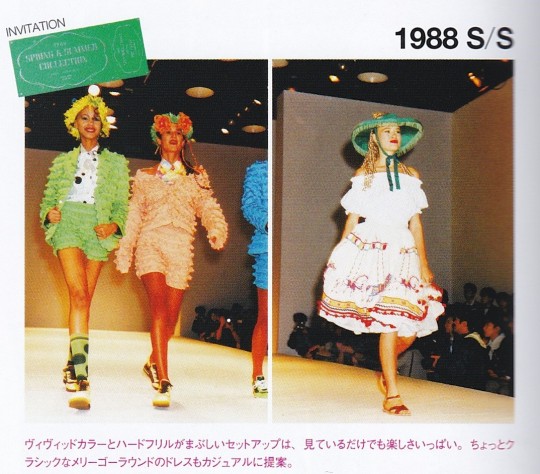

By the early 1990s, MILK was heavily featured in coordinates worn by young women who considered themselves lolita in magazines like Cutie and Zipper, and was also advertising in those magazines.
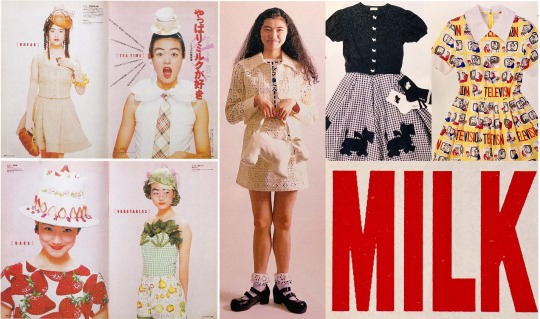
1990-1992 Cutie advertisements for MILK
Early 1990s looks from MILK were fairly consistent with what was on offer from similar shops like PRETTY and Shirley Temple.



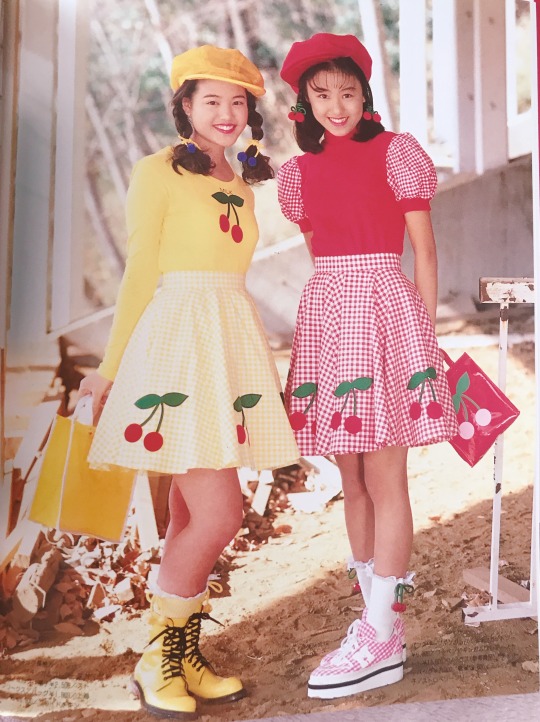
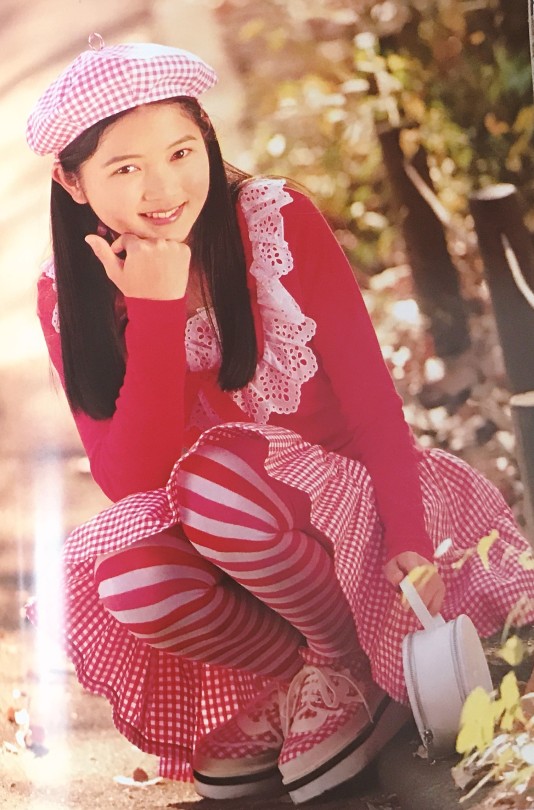

MILK Coordinates from Nene magazine, 1995
Speaking of Shirley Temple, the founder of Shirley Temple, Rei Yanagawa (柳川れい), worked as a designer for MILK before starting the Shirley Temple children's brand in 1974.
As time went on, lolita fashion started to diverge from the MILK style, while MILK followed their own design concept and look more at current trends in girly fashion. Today, some iconic MILK items like their heart purse are still frequently used in lolita fashion, however, it would be difficult to walk into MILK today and put together a coordinate that would read the same as one made from items at Angelic Pretty.
While goth and punk brands typically have no issue relating themselves to goth or punk fashion, brands popular with lolita have sometimes resisted self-describing themselves as lolita, most likely in an attempt to not alienate non lolita customers, due to lolita fashion having a mixed reputation. MILK, like many other Japanese brands, especially DC brands, maintains that they make MILK style, even though their influence on what we call lolita fashion today, is unmistakable.
Past Posts:
Olive Girls
#MILK#Old School Lolita#Lolita Fashion History#Shirley Temple#90s Jfashion#80s Jfashion#70s Jfashion#Lolita History#Central Apartment#Hitomi Okawa#Mini Lolita History Lesson
323 notes
·
View notes
Text










Lolita fashion inspired by Vietnam’s Nguyễn dynasty era (1802-1946) fashion. Credit to V’style.
#vietnam#vietnamese#culture#history#sinosphere#fashion#historical fashion#vietphuc#viet phuc#lolita style#lolita clothing#lolita fashion#sweet lolita#classic lolita#lolita dress#lolita coord#lolitagirl
231 notes
·
View notes
Text
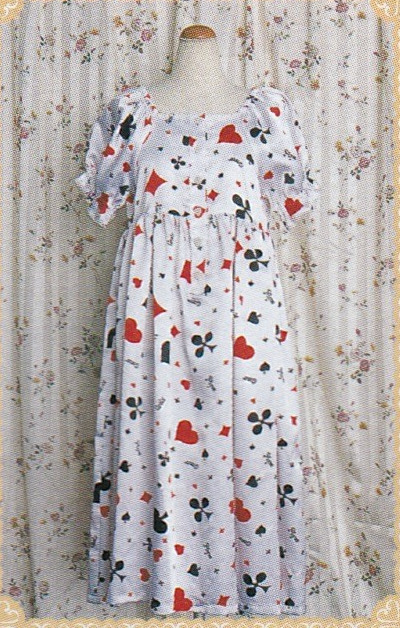

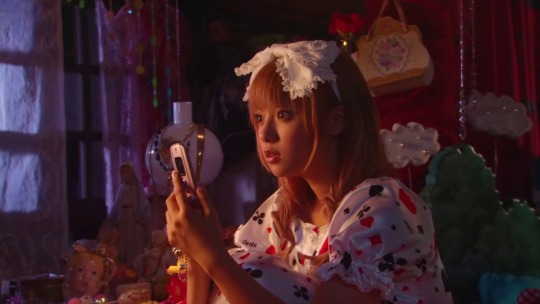
Hiromi Saruya x BABY, the Stars Shine Bright - Trump Print Satin OP (2004)
This one-of-a-kind dress was never released for commercial sale; designed by Hiromi Saruya and produced by BABY, the Stars Shine Bright for the 2002 film Shimotsuma Monogatari, we see Momoko pair this OP with a matching parasol and BABY brand alice bow. Due to being a stage costume, this piece is likely lost in circulation, in the hands of a second hand shop, costume and prop storage, or a private owner.
#hiromi saruya#kamikaze girls#shimotsuma monogatari#egl community#egl fashion#egl#elegant gothic Lolita#baby the stars shine bright#BtSSB#lolita history#sweet lolita#old school lolita#kawaii fashion#jfashion#alt fashion#harajuku fashion#costumery#trump satin print op#my post tag
360 notes
·
View notes
Text

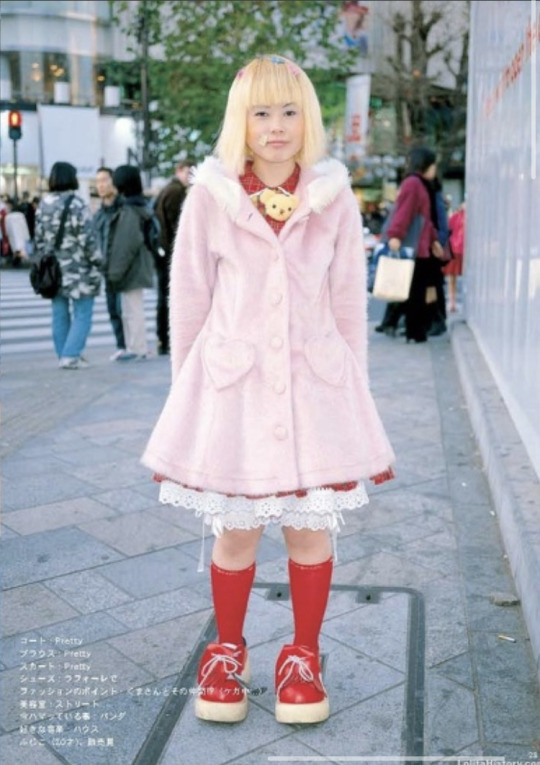



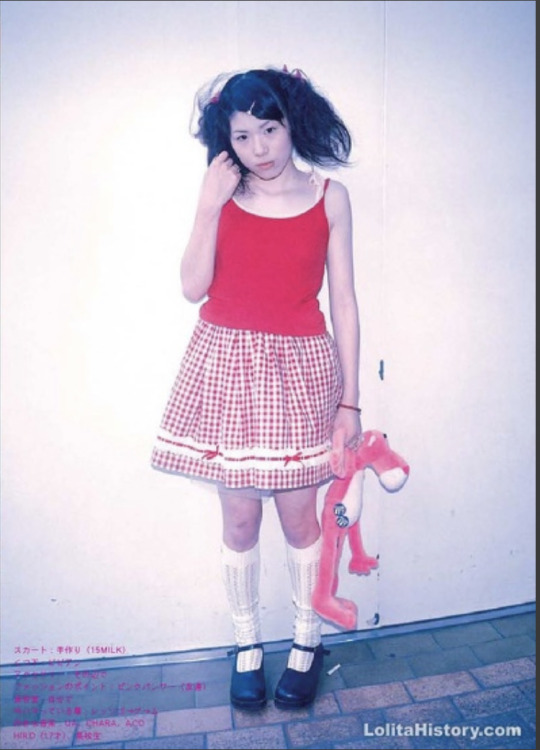



90’s lolita fashion from FRUiTS pt. 2 (scans from Lolita History) 🍓🍒
379 notes
·
View notes
Text

They/he | A little walk
107 notes
·
View notes
Text

This is a classic ancient piece of Lolita history, an archived site, of translations from 2001-2002 of Lolitas on 2chan complaining.
You can view it here.
155 notes
·
View notes
Text
"PRETTY" before angelic pretty?
Does anyone have more photos of the brand Pretty before they became Angelic Pretty? I found just a few online...
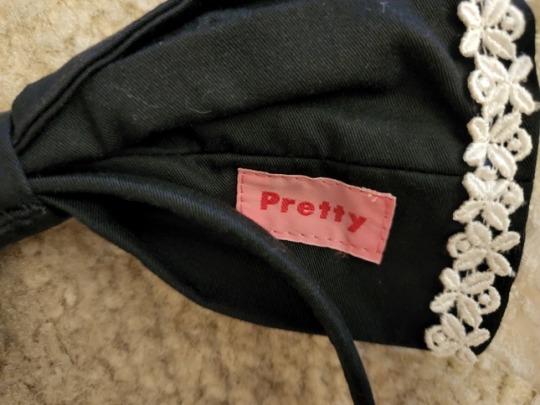
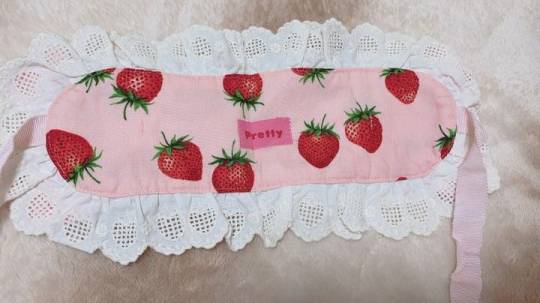
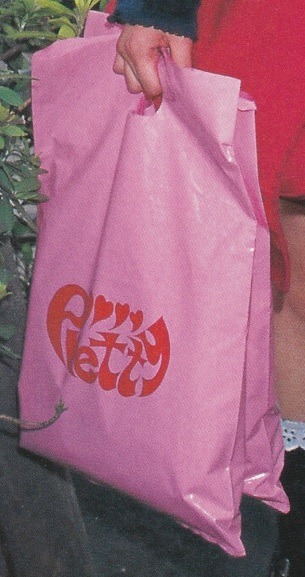
I think I recall seeing a fluffy dog purse on lacemarket a few months ago as well, but couldn't find it again!
I love learning about lolita history and proto lolita style. So please let me know!
199 notes
·
View notes
Text
Academic research into Lolita fashion
Hello! I'm Alex, I'm an Art History student at university and I'm currently working on a paper about Lolita fashion. I just wanted to ask if anyone has any sources, like books, articles or anything of the sort I could use as sources, since I'm having some trouble finding stuff on the matter. I can also use videos, podcasts, documentaries and other stuff as sources, just as long as they're reliable enough.
I'm also looking for some testimonials of people who wear lolita fashion, since I wanna talk about the subculture and how the people who are into it engage with it. If you know anything related to that (or if you'd like to talk to me about it) feel free to tell me as well!
I'll be checking this post but you can also message me/send me an ask with stuff. I would really appreciate it!
if there's any interest i wouldn't mind sharing my paper after i've presented it of course!
#lolita fashion#sweet lolita#gothic lolita#i'm kinda scared of tagging it just lolita bc i know websites can be DUMB about that tag#japanese fashion#harajuku#j fashion#so sorry for bothering in the main tags#also this isn't for a grade or anything (i'm literally doing it for fun and to share with fashion history nerds like me)#but i do have a deadline of about may 20th
23 notes
·
View notes
Text
Inspo for my next handmade project

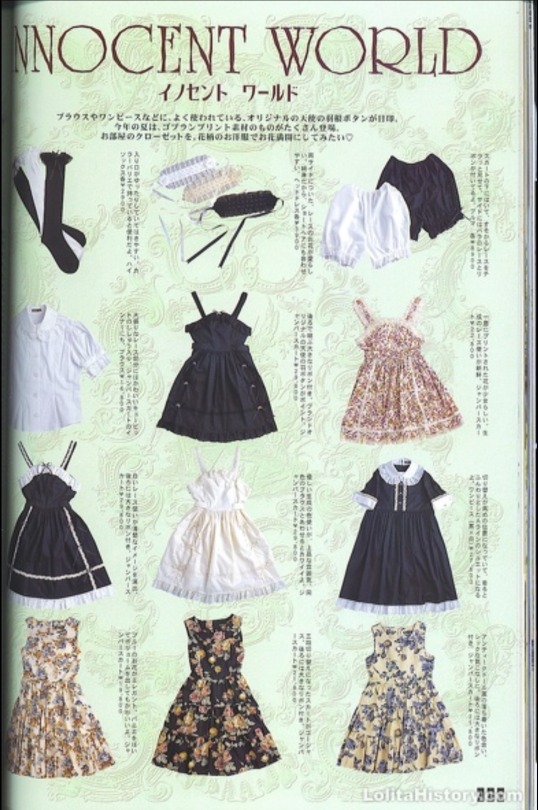
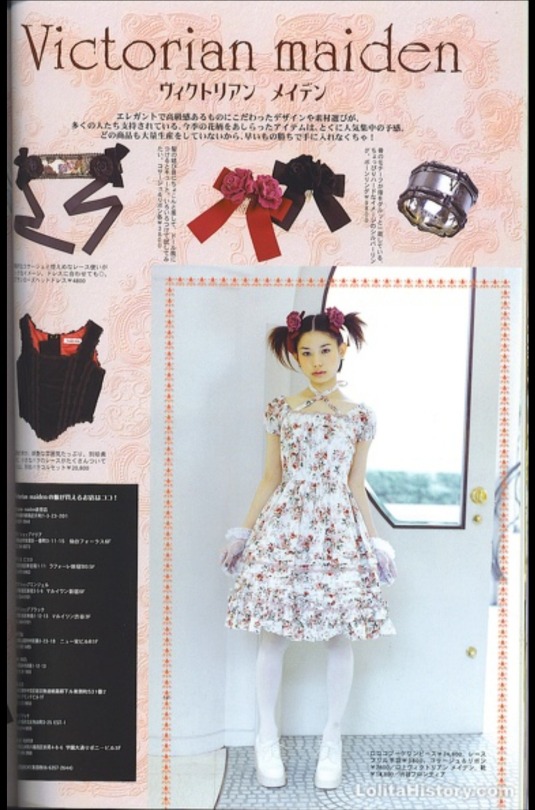
After my first handmade skirt I got excited and now I want to make a full OP ▼・ᴥ・▼
This is something that made me fall in love with lolita since the very beginning: the strive for creativity and experimentation. I once again want to use the fabric of a garment that I no longer use to create a new and unique piece!
Maybe I'm getting a little too excited, after all I've never done a full dress from scratch before, so I'll be kind to myself if I make some mistakes and learn from them. (✪㉨✪)
I'm still new to lolita, so getting brand pieces and filling my wardrobe has been hard since I don't have a lot of money (I work selling my art and it doesn't pay off much lol). I've been buying clothing from local lolita brands since their more accessible for me, but I think that learning to sew it's gonna save me from bankruptcy :,-)
I'm gonna follow some instructions that I found on the internet, I plan on documenting the process so I will share the tutorial that I'm gonna follow when I finish it in a future blog. Wish me luck! (♡ω♡ ) ~♪
#the mmm scan is from the glb vol. 1 and the iw and vm ones from vol. 2#not my scans#found them on lolita history#lolita fashion#gothic lolita#old school lolita#egl fashion
41 notes
·
View notes
Text

Popularity ranking of lolita, girly kei, and goth punk brands based on readers choice voting in "Alice a la Mode" magazine (vol. 4, released 2010).
#alice a la mode#ガーリー#ガーリー系#ロリータファッション#ゴスパンク#girly kei#lolita fashion#goth punk#jfashion#information#jfashion history
103 notes
·
View notes
Text
Politics and Fashion
Hello. My name is Lucy and I am conducting research for my Year 12 Society and Culture HSC major work on how politics affects fashion. If you see this I would be incredibly appreciative if you could fill out the following questionnaire and spread it around. All answers are completely confidential.
https://forms.gle/is3eR2xbFSNECRHR6
Thank you so much in advance!!
#questionnaire#polls#survey#fashion#alt fashion#disability#pop punk#cripple punk#emo aesthetic#gothic lolita#alt goth#goth aesthetic#goth#kidcore#cottagecore#aesthetic#history#fashion history
27 notes
·
View notes
Text
Mini Lolita Fashion History Lesson: Olive Girls
Olive magazine was a magazine that launched in 1982 as a magazine aimed at young women / teens. It was highly influential and the girls who read the magazine were often called “Olive Girls”. Because girls who read olive tended to dress a certain way and/or because girls who dressed a certain way tended to read Olive, the term olive girl became an umbrella term to describe those styles.
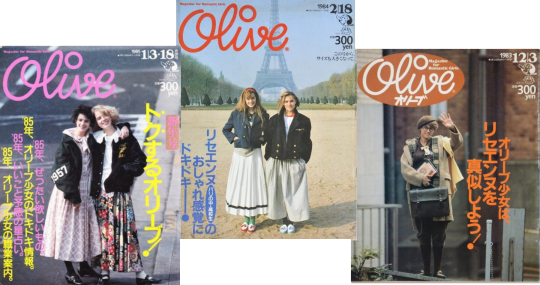
In “The Cute Empire“, the author breaks down the Olive Girl styles into 3 major style tribes. One of those was “Girly” fashion style that used ribbons and frills, floral prints and other feminine motifs. The overall look had a fairy-tale like feel, included characters like alice in wonderland, and popular brands were Isao Kaneko’s Pink House, Wonderful World, MILK, AO and other similar brands.
Pink House and Wonderful World were both designed by Kaneko Isao, and their style is usually called things like Pink House Style or Kaneko Style / Kaneko-kei. English speaking Jfashion communities sometimes call this style Natural-kei, but this is somewhat of a misnomer as there is a different style called Natural-kei in Japan that is completely unrelated.
As for AO and MILK, in 1994, Zipper magazine published an article talking about what lolita fashion was and the origins of the style. In that piece they interview people from AO and MILK, citing them as being lolita brands. (Interestingly, the PR person for MILK at the time replies back that what people are calling lolita at that time is just the style MILK has always made…). And, slightly before that, in 1993, Cutie Magazine published some spreads that showed what they considered lolita fashion. Items from MILK and AO were again included.


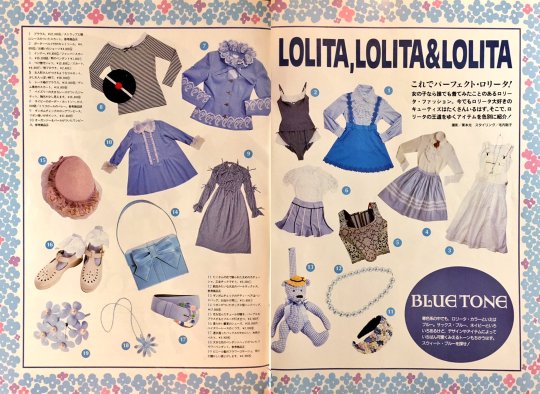
#Lolita Fashion History#Olive Girls#Old School Lolita#Pink House#Atsuki Onishi#Wonderful World#Milk#Zipper#Cutie#Olive#90s Jfashion#80s Jfashion#Lolita History#Mini Lolita History Lesson
128 notes
·
View notes
Text
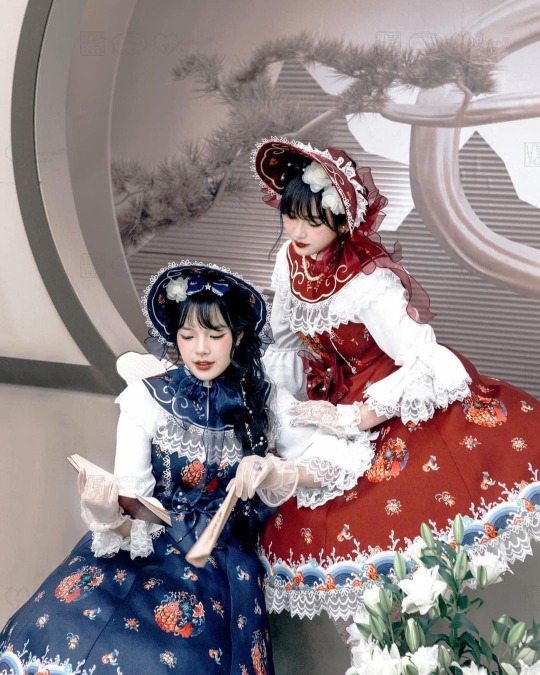


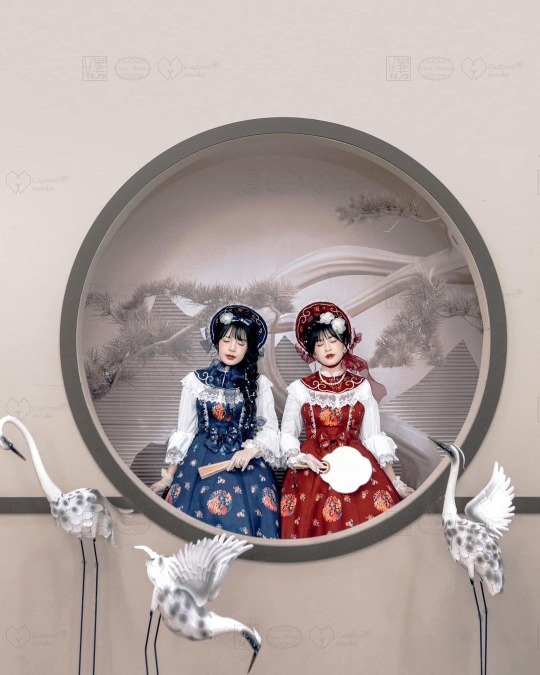





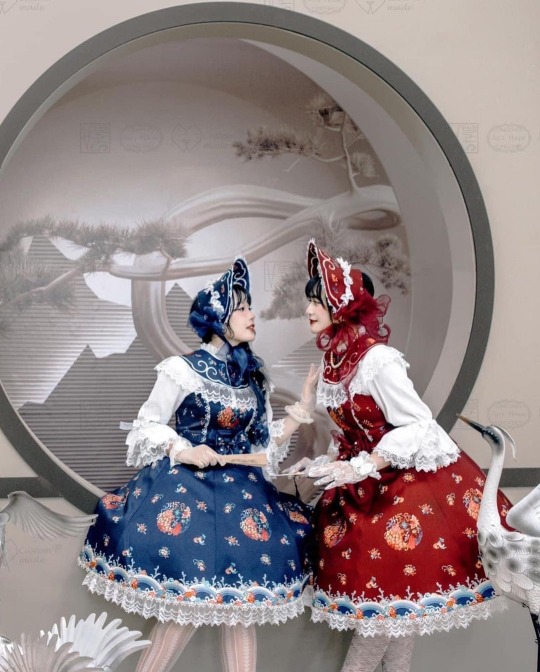
Lolita fashion inspired by Vietnam’s Nguyễn dynasty era (1802-1945) fashion. Credit to V’style.
#vietnam#vietnamese#culture#history#sinosphere#fashion#historical fashion#vietphuc#viet phuc#lolita style#lolita clothing#lolita fashion#sweet lolita#classic lolita#lolita dress#lolitagirl#lolita coord
87 notes
·
View notes
Text



Hiromi Saruya x BABY - Ribbon Summer Dress Set
This one-of-a-kind dress and full bonnet-cap by Hiromi Saruya collaborating with BABY, the Stars Shine Bright was never released for commercial sale. It was designed as a stage-costume for the 2002 movie, Kamikaze Girls.
The set is likely lost in circulation, either in the possession of a second-hand vintage shop, prop and costume storage, or private owner.
#baby the stars shine bright#shimotsuma monogatari#btssb#kamikaze girls#egl community#lolita fashion#lifestyle lolita#roomwear#egl#elegant gothic lolita#lolita history#egl history#egl lifestyle#ribbon summer dress set#sample sets#sweet lolita#old school lolita#my post tag
488 notes
·
View notes
Text
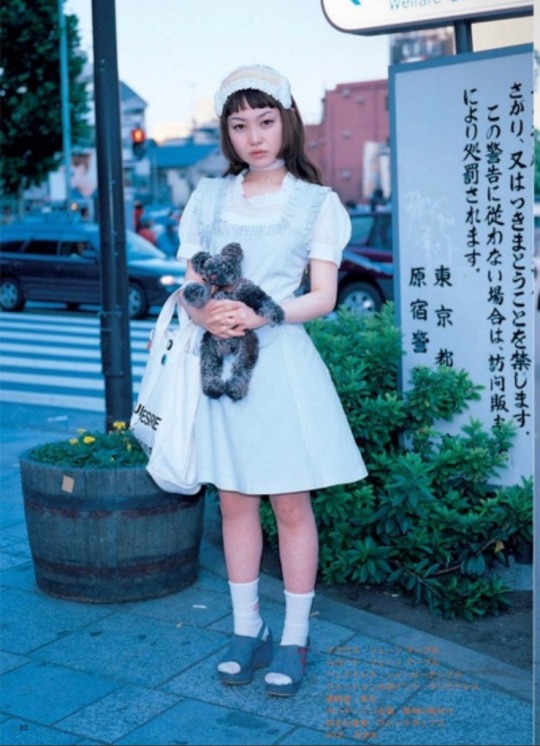
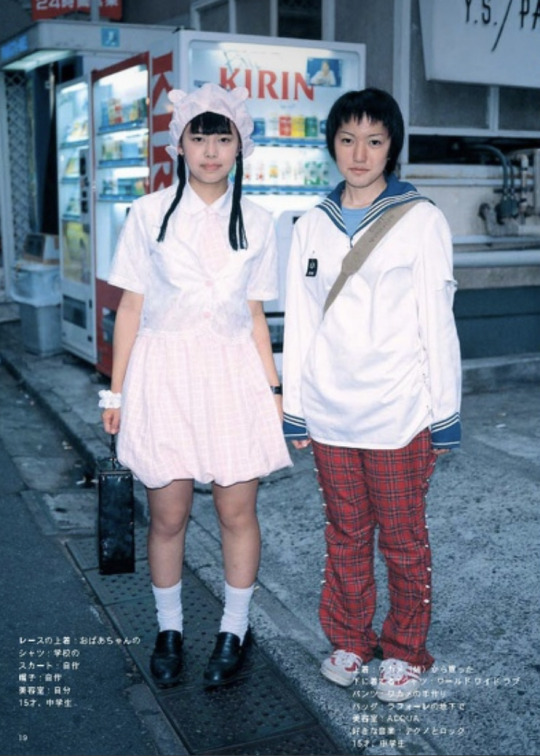


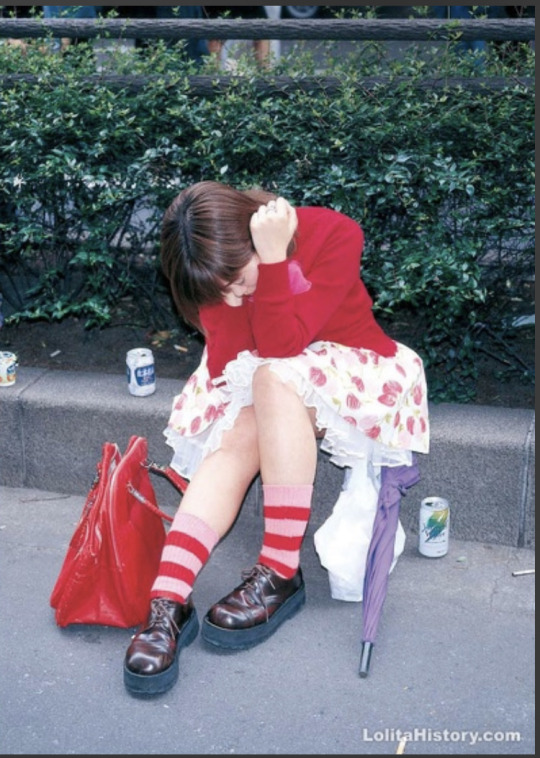

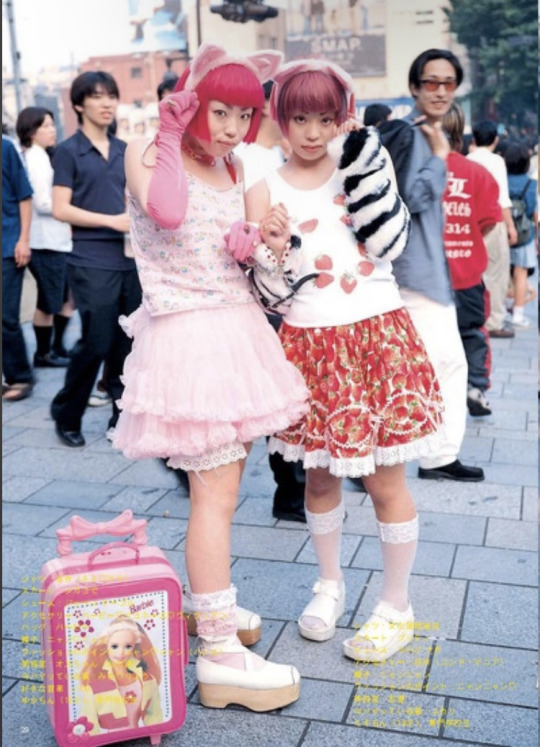
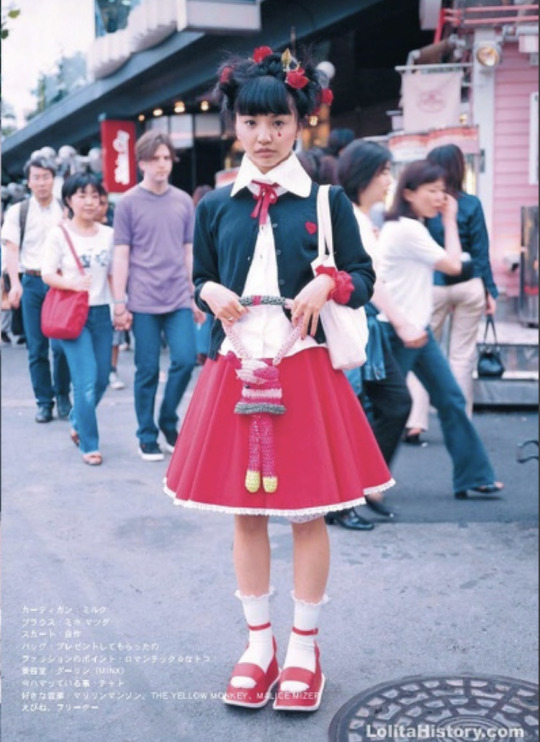
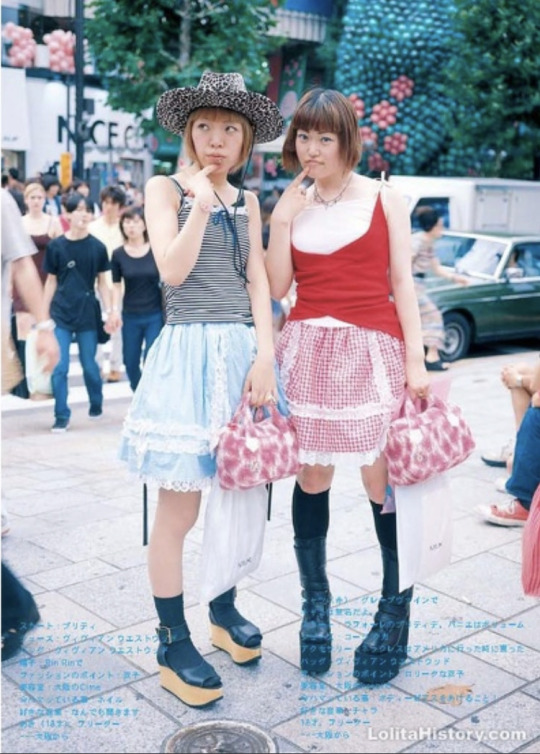

lolita fashion from 90’s FRUiTS magazines (scans from Lolita History) 🍓🍒
#lolita fashion#fruits magazine#lolita history#fashion#there are so many items from Pretty I really want to like. try and make a list of them now since idk if they’re in lolibrary
344 notes
·
View notes
Text
Sharp Blades, Soft Frills: Femme rebellion in lolita fashion, Japan.

Hamuka stares down the camera, spiked bat in hand. Fingers entwined around the sharp nails, she rests it against her decadently frilly lolita fashion dress. She’s wearing an “Elizabeth Doll” dress and matching headdress by BABY the STARS SHINE BRIGHT, the most coveted dress in the lolita scene this year. As a lolita in Tokyo, Hamuka stages and curates a collection of images on her Instagram @Hamukahamu and her zine Missing Magazine.
Hamuka’s goal is to explore the connections between feminism and lolita fashion. “I think that lolita fashion’s independent spirit makes for the image of a strong woman. You are freed from the male gaze and dress only for yourself,” she explains.
In the first issue of her zine “I Want to Be Your Queen”, Hamuka explores gender, sisterhood and independence through her interpretations of Queen’s music. In her photos, she glowers in her soft frills, giving her femme audience a knowing, recalcitrant look. Soft and fierce, Hamuka is ready to take on the world.
Lolita fashion has been part of Japan’s rich alternative scene for over 40 years. It is a celebration of self and is intended to provide a ‘hyper-femme space’ away from the imposition of the male gaze. Not to be confused with Vladmir Nabakov’s (1955) Lolita, this movement actually uses the word “lolita” to mean frilly “French-inspired” fashion. A big influence on lolita fashion is kawaii and Japanese “girl culture” which is for anyone of all genders and ages.
Both spicy in their hot-takes and dreamy in the spectacular world they make together, lolitas pursue their interest in frilly excess with a ferocious independence. In this article I outline what lolita is in the context of frilly rebellion, drawing on my 10 years of close consultation with the Japanese community as an academic and as someone who has been part of the global scene for 15 years. In this essay, I have also consulted with the lolitas I discuss about their own practice, working collaboratively with them to capture their views and concepts.
Read it at Anime Feminist!
#lolita fashion#elegant gothic lolita#lolita style#fashion history#articles#baby the stars shine bright
63 notes
·
View notes